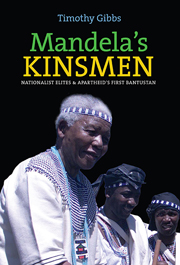Book contents
- Frontmatter
- Contents
- List of Maps and Figures
- Acknowledgements
- List of Abbreviations
- Introduction: Mandela' Kinsmen
- 1 Education, Monarchy & Nationalism
- 2 The First Bantustan, 1954–1963
- 3 The Second Peasants' Revolt, Mpondoland 1960–1980
- 4 The Old Mission Schools, 1963–1980
- 5 The Comrade-King, Bantustan Politics 1964–1980
- 6 Chris Hani's Guerrillas, 1974–1987
- 7 The Apartheid Endgame, 1987–1996
- 8 The New South Africa & Transkei's Collapse, 1990 onwards
- Conclusion: African Nationalism & its Fragments
- Bibliography
- Index
8 - The New South Africa & Transkei's Collapse, 1990 onwards
Published online by Cambridge University Press: 05 April 2014
- Frontmatter
- Contents
- List of Maps and Figures
- Acknowledgements
- List of Abbreviations
- Introduction: Mandela' Kinsmen
- 1 Education, Monarchy & Nationalism
- 2 The First Bantustan, 1954–1963
- 3 The Second Peasants' Revolt, Mpondoland 1960–1980
- 4 The Old Mission Schools, 1963–1980
- 5 The Comrade-King, Bantustan Politics 1964–1980
- 6 Chris Hani's Guerrillas, 1974–1987
- 7 The Apartheid Endgame, 1987–1996
- 8 The New South Africa & Transkei's Collapse, 1990 onwards
- Conclusion: African Nationalism & its Fragments
- Bibliography
- Index
Summary
Mandela's moral homilies
If the democratic transition allowed many of the region's elite to secure high office in the new South Africa, Transkei itself imploded. Ironically, some of the greatest challenges to Bantu Holomisa's military government in the early 1990s came from the more disorderly elements within the broad nationalist alliance. After Holomisa unbanned the liberation movements, a plethora of organisations, political groups and local initiatives mushroomed. From their base in Umtata, a hastily formed Interim Regional Executive Committee, nominated in early 1990 by the ANC national leadership, struggled to gain some control of events. The ex-Robben Islander, Alfred Xobololo, was made chair of the Transkei Regional Executive. Samson Fadana, aged 69, one year older than his friend in the chair, was the most senior figure in the committee. Below them were the next generation of stalwarts in the struggle – including Zoleka Langa, Mzolisi Mabude, Prince Madikizela, Harris Majeke and Ezra Sigwela. Then there was a smattering of Soviet-trained thirty-somethings such as Pumzile Mayaphi, who had risen rapidly in the MK during the 1980s. They would struggle to establish control over many of the organisations that were notionally aligned to the ANC.
South Africa's historians typically have seen these conflicts as expressive of the deep social divisions within the Bantustans. Rural society had been transformed by the burgeoning ranks of youth – both unemployed miners returned from urban centres and disaffected students – who brought new styles of political action into the rural areas. Insurgents struck out from below against the corrupted Bantustan authorities. At the same time, the beneficiaries of the Bantustan system also mobilised to maintain their privileges.
- Type
- Chapter
- Information
- Mandela's KinsmenNationalist Elites and Apartheid's First Bantustan, pp. 155 - 175Publisher: Boydell & BrewerPrint publication year: 2014

